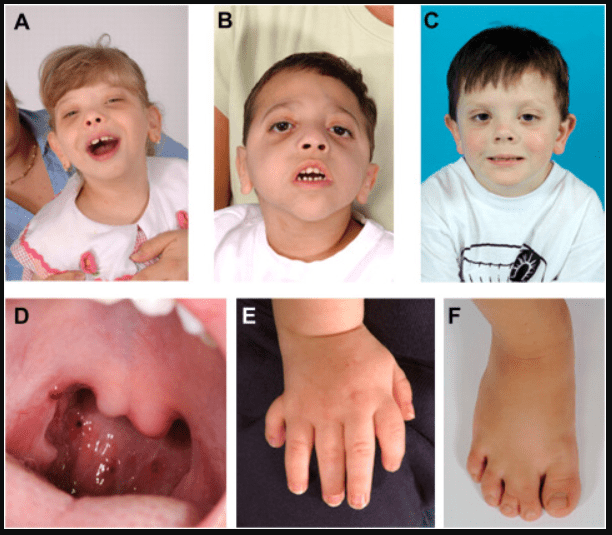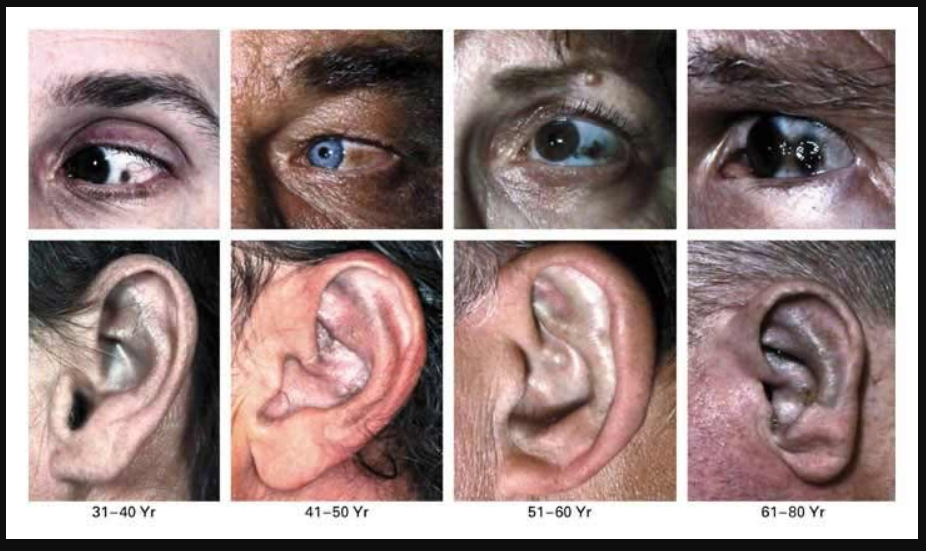This world has no shortage of genetic disorders. However, some are so rare that many people haven’t heard of them. Several rare genetic diseases affect a few people worldwide, and most present unique challenges for diagnosis and treatment.
What are these rare genetic medical conditions? Thankfully, you will learn more about them here in this post. So read on to see our list of the rarest genetic disorders in the world!
9. Smith-Lemli-Opitz Syndrome
Date identified: 1964
Discovered by: David W Smith, Luc Lemli, and John Opitz
Body parts affected: multiple body systems

Smith-Lemli-Opitz Syndrome (SLOS) is a rare genetic condition affecting multiple body parts. SLOS is caused by a faulty gene, leading to a deficiency in cholesterol synthesis.
As an autosomal recessive genetic condition, it can only be passed on when both parents carry the defective gene, which makes the disorder rare. Symptoms can range from mild to severe and affect growth, cognitive function, and physical features.
Doctors diagnose SLOS using genetic testing, specifically by examining the DHCR7 gene. A person with SLOS has a mutated DHCR7 gene that alters the 7-dehydrocholesterol reductase enzyme. In addition, chorionic villus sampling and amniocentesis are two prenatal diagnostic techniques that experts use to detect SLOS in utero.
Did you know?
At this time, there’s no known cure for Smith-Lemli-Opitz Syndrome. So instead, doctors focus treatment on managing symptoms, including physical and occupational therapy, cholesterol supplementation, and surgical interventions.
8. Maple Syrup Urine Disease
Date identified: 1954
Discovered by: John Menkes
What is affected: metabolism

Maple Syrup Urine Disease (MSUD) is a rare inherited metabolic disorder in which the body cannot process certain protein building blocks, known as branched-chain amino acids. This results in a buildup of toxic substances in the blood, leading to serious health complications.
MSUD can be life-threatening if not treated promptly, and babies with MSUD require immediate treatment to prevent brain damage, coma, or even death. Although a rare condition, it is essential to diagnose and manage MSUD to improve the quality of life of those affected.
Did you know?
The urine of infants with MUSD emits a sweet smell, like maple syrup. This inspired the name of the disease as “maple syrup urine disease.”
7. Niemann-Pick Disease
Date identified: 1914
Discovered by: Albert Niemann
What is affected: multiple organs

Niemann-Pick Disease is a rare inherited metabolic disorder that affects many body systems. It is caused by the body’s inability to metabolize cholesterol and other lipids, leading to their accumulation in the body’s cells.
Common symptoms of Niemann-Pick Disease include an enlarged liver and spleen and lung and nervous system problems. However, the severity of these symptoms varies widely, depending on the type of the disease.
Did you know?
Niemann-Pick Disease (NPD) encompasses several types associated with distinct gene mutations and relevant metabolic pathways that affect lipid metabolism. Two of the most common types are NPD A and B. Both are caused by mutations in the SMPD1 gene and lead to spleen, liver, and lung dysfunction.
6. Aarskog Syndrome
Date identified: 1970
Discovered by: Dagfinn Aarskog
What is affected: growth hormone

Aarskog Syndrome, also known as Aarskog-Scott Syndrome, is a rare genetic condition affecting multiple body parts. Short stature, facial abnormalities, and skeletal and genital anomalies characterize this condition. It mainly affects males since it is linked to the X chromosome, although females may have a milder form. The condition is caused by a mutation in the FGD1 gene, affecting how certain body parts grow.
5. Alkaptonuria
Date identified: 1908
Discovered by: Archibald Garrod
What is affected: metabolism

Alkaptonuria is a genetic disorder that affects only a few individuals worldwide. This disorder arises from the deficiency of an enzyme called homogentisate 1,2-dioxygenase. This lack of enzyme leads to the accumulation of homogentisic acid in the body, which then causes urine to turn black when exposed to the air.
Though it is not life-threatening, Alkaptonuria is a rare condition that can cause joint pain, stiffness, and even heart problems. People with Alkaptonuria also tend to have a bluish-gray pigmentation of the eyes’ sclera and the ears’ cartilage.
Did you know?
Alkaptonuria is a rare genetic disorder because of the low probability of getting it. As an autosomal recessive disorder, a person should inherit two defective genes, one from each of their parents, to develop the condition.
4. Lesch-Nyhan Syndrome
Date identified: 1964
Discovered by: Michael Lesch and William Nyhan
What is affected: kidney and blood

Lesch-Nyhan Syndrome (LNS) is a rare genetic disorder that affects the body’s ability to metabolize purines, resulting in the overproduction of uric acid. A host of neurological and behavioral symptoms, including self-injurious behavior, spasticity, and intellectual disability, characterize it.
Treatment for LNS is primarily supportive and may include medication to control symptoms such as gout and spasticity and therapy to address behavioral and emotional challenges. While there is no cure for LNS, ongoing research is being conducted to better understand the underlying genetic factors and explore potential treatments.
Did you know?
Lesch-Nyhan Syndrome primarily affects males. The disorder is inherited in the X chromosome, carried by the mother, and passed to her children.
3. Harlequin Ichthyosis
Date identified: 1750
Discovered by: Oliver Hart
What is affected: skin

Harlequin Ichthyosis is a severe genetic skin disorder that affects newborn infants. It is caused by a genetic mutation that results in thickened skin over nearly the entire body at birth.
The newborn is covered with hard, thick skin plates forming large diamond-shaped patterns. The skin is also prone to cracking and splitting apart, exposing babies to the risk of severe infections.
There is currently no cure for this disorder, but treatments such as topical creams and antibiotics can alleviate symptoms and prevent infections.
Did you know?
Having Harlequin Ichthyosis causes the skin to develop diamond-shaped scales. This has inspired doctors to treat the disorder as Harlequin Ichthyosis, which “harlequin” refers to the diamond pattern found in a Harlequin costume.
2. Fibrodysplasia Ossificans Progressiva (FOP)
Date identified: 1692
Discovered by: Guy Patin
Body parts affected: bones and connective tissues

Fibrodysplasia Ossificans Progressiva (FOP) is one of the rarest genetic disorders today, affecting about 1 out of every 1 to 2 million people worldwide.
FOP is characterized by the growth of bone in muscles, tendons, and other connective tissues. This formation of bone, known as heterotopic ossification, causes joint stiffness and immobility.
Interestingly, FOP has been called the “Stone Man Syndrome” because those with this condition can become immobilized in a second “skeleton” of bone. What’s sad about this disorder is that even minor injuries, such as falls or bruises, can stimulate the body’s ossification process in FOP patients.
Did you know?
Doctors once tried to remove new bones formed due to FOP. However, they later found out that a new bone would grow back, and they could be more aggressive than what was first removed.
1. Hutchinson-Gilford Progeria Syndrome (HGPS)
Date identified: 1886
Discovered by: Dr. Jonathan Hutchinson
Body parts affected: skin, bones, muscles, and heart

Hutchinson-Gilford Progeria Syndrome (HGPS) is the rarest genetic disorder in the world, which affects 1 to 4 to 8 million children worldwide. It is a rare genetic disorder that affects only a few hundred people worldwide. HGPS results from a genetic mutation that causes rapid aging in children, typically leading to death at an average age of 14.
This progressive disorder causes growth retardation, baldness, skin changes, body fat loss, joint stiffness, and cardiovascular problems. It is an autosomal dominant condition, meaning it only requires one parent’s genetic contribution to be passed on to their child.
Despite its rareness, the medical community has responded vigorously to HGPS by instigating studies and research to find new treatments to address the disorder. Clinical trials, such as gene therapy, have provided hope in reversing some of the symptoms of this syndrome.
Did you know?
Experts who studied Hutchinson-Gilford Progeria Syndrome made significant discoveries that helped modern scientists better understand aging. This led to identifying new therapies and management methods for age-related diseases.
